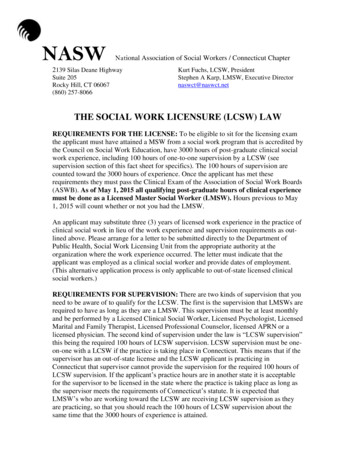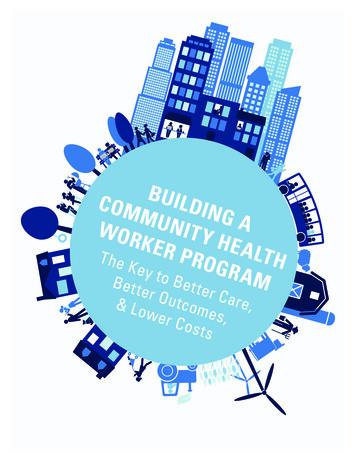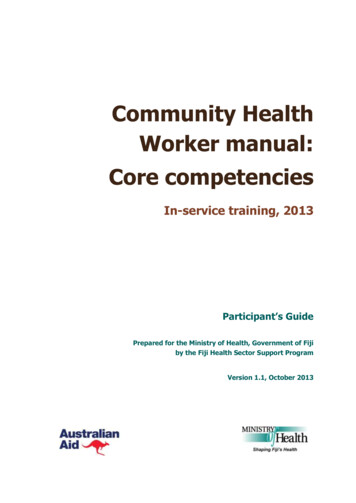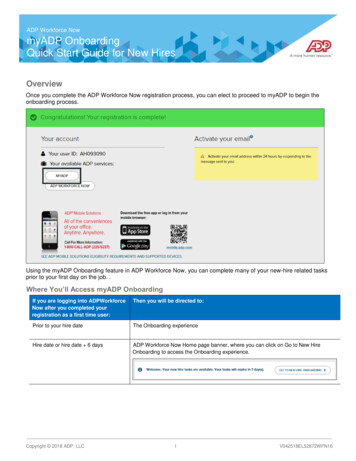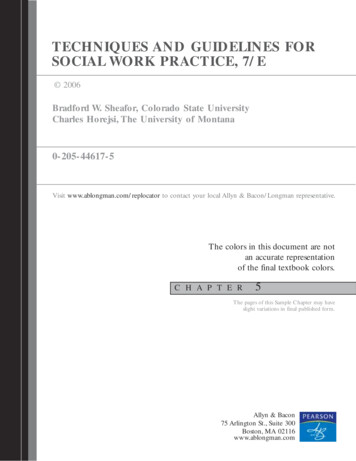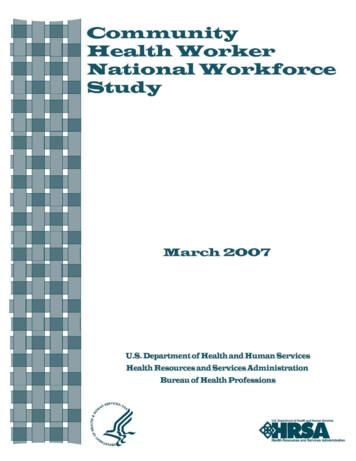
Transcription
Community Health Worker National Workforce StudyMarch 2007U.S. Department of Health and Human ServicesHealth Resources and Services AdministrationBureau of Health Professions
PrefaceDuring the past decade, private insurers, business enterprises and the Federal governmenthave implemented or proposed changes in health care delivery and financing. Thesepayers were reacting to unprecedented increases in health-related expenditures amidhypercompetitive global markets. Simply, the cost of providing adequate health care toemployees and the population at large had become very high.Some viewed the community health worker (CHW) workforce as a component of costeffective strategies addressing the health care needs of underserved communities.However, there was little rigorous, comprehensive research about the CHW workforce.This report describes a comprehensive national study of the community health workerworkforce and of the factors that affected its utilization and development. The researchbegan in 2004 and was concluded in 2007 by the Regional Center for Health WorkforceStudies of The University of Texas Health Science Center at San Antonio under contractNo. HHSH230200432032C awarded by the United States Department of Health andHuman Services, Health Resources and Services Administration, Bureau of HealthProfessions. The Evaluation and Analysis Branch, Office of Workforce Analysis andQuality Assurance, BHPr, HRSA, was responsible for overseeing the research project.ii
Executive SummaryIntroduction (Chapter 1). This report describes a comprehensive national study of thecommunity health worker (CHW) workforce. The 27-month research project utilized asurvey of verified CHW employers in all 50 States, more in-depth interviews ofemployers and CHWs in 4 States, conducted a comprehensive review of the literature,and made national and State workforce estimates using databases from the Census andthe U.S. Department of Labor, Bureau of Labor Statistics.During the past decade, private insurers, business enterprises, and the Federalgovernment, responding to the high cost of providing adequate health care to employeesand the population at large, implemented or proposed changes in health care delivery andfinancing. Some of the factors contributing to the cost challenges included populationchanges, provider shortages, accelerating technological progress, and the increasingcomplexity of the health care system. Population projections have been predicting a largeincrease in the U.S. elderly population (estimated to be 87 million in 2050) and, due tohigher fertility among minorities, an increase in population diversity and the size ofyounger cohorts of individuals from low-income families. These changes in the size,structure and diversity of the population have been and will be requiring a broader rangeof health services for entire families and communities. Cultural understanding,community health education, and translation services have been and will be increasinglyneeded for delivering effective care to families and communities that are often isolatedand underserved. Additionally, many providers are in short supply and have been caringfor increasingly large and diverse patient populations in regulated environments thatdiscourage patient/provider interaction and continuity of care. The diffusion of newscience and technology while offering encouraging solutions has not yet reached a scalelarge enough to outpace providers’ shortages and the escalating cost of care. However,telemedicine and new methods of disseminating scientific information have beenempowering individuals with less extensive clinical training but strong personal andcommunity skills to become valuable members of established medical teams forimproving access, patient communication and compliance, outreach, prevention, andearly diagnoses in underserved communities.These converging demographic and economic forces set the stage for the emergence ofthe community health worker workforce and its utilization in cost containment and costeffective strategies aimed at providing health care to the underserved.CHW DefinitionCommunity health workers are lay members of communities who work eitherfor pay or as volunteers in association with the local health care system inboth urban and rural environments and usually share ethnicity, language,socioeconomic status and life experiences with the community members theyserve. They have been identified by many titles such as community healthiii
advisors, lay health advocates, “promotores(as),” 1 outreach educators,community health representatives, peer health promoters, and peer healtheducators. CHWs offer interpretation and translation services, provideculturally appropriate health education and information, assist people inreceiving the care they need, give informal counseling and guidance onhealth behaviors, advocate for individual and community health needs, andprovide some direct services such as first aid and blood pressure screening.Chronology of CHW workforce development (Chapter 2). The history of communityhealth workers is rooted in early self-preservation and self-reliance strategies bycommunities the world over. However, references in the U.S. literature about CHWactivities are found mostly after the mid-1960s. For this study, selective lists of criticalevents marking the evolution of the CHW workforce have been grouped into fourperiods. During the early documentation period (1966-1972), the attempts to engageCHWs in low-income communities were experimental responses to the persistentproblems of the poor and related more to antipoverty strategies than to specificmodels of CHW intervention for disease prevention and health care. The next period (1973-1989) was characterized by special projects funded byshort-term public and private grants, often linked to research in universities, andproduced a substantial increase in published studies documenting CHWs’potential in interventions aimed at health promotion and access to health services. State and Federal Initiatives (1990-1998) followed. Standardized training forCHWs received greater recognition and there was a surge of communicationamong CHW initiatives across categorical funding programs. Many bills insupport of CHW activities were introduced at the national and State levels, butnone passed. The latest period included significant Public Policy (1999-2006) actions.Legislation specifically addressing CHWs, their use and their certification waspassed in several States and a Patient Navigator bill was signed into law as amajor piece of legislation at the Federal level addressing CHW activities. Also, a2003 Institute of Medicine report on reducing health disparities maderecommendations regarding CHW roles.Workforce size and characteristics (Chapter 3). There is no specific occupational codethat can be used in official reports for community health workers and, therefore, there areno official estimates of the number of community health workers (CHWs) in the UnitedStates. Until now, these workers have been reported under existing occupations that havesimilar but not equivalent job descriptions.For this study, estimates were made of volunteer and paid CHWs in each of the 50 States,first by making an assessment of the occupations that were likely to have been used as1The terms promotores and promotoras are used in Mexico, Latin America, and Latino communities in the UnitedStates to describe advocates of the welfare of their own community who have the vocation, time, dedication, andexperience to assist fellow community members in improving their health status and quality of life. Recently, the termshave been used interchangeably, despite some opposition, with the term community health workers.iv
proxies for community health worker activities in reports to the Bureau of LaborStatistics and the Census Bureau. Then, the approximate percent of individuals in thoseoccupations likely to be CHWs was determined. The occupations included in theestimates were counseling, substance abuse, educational-vocational counseling, healtheducation, and other health and community services. CHWs were estimated to be from 5to 40 percent of the workers engaged in these occupation/industry categories and theywere either wage earners (67 percent) or volunteers (33 percent) in not-for-profit and forprofit organizations such as schools, universities, clinics, hospitals, physician offices,individual-family-child services, and educational programs.Approximately 86,000 community health workers assisted American communities in2000. California and New York were home to about 9,000 and 8,000 CHWs,respectively. Texas, Florida, and Pennsylvania had between 3,500 and 5,000 CHWseach. The States of Illinois, Ohio, and Georgia had, in that order, a CHW workforce of3,520, 3,503, and 3,250. Ten States employed approximately 2,000 CHWs each, 7 Statesabout 1,000 CHWs and the remaining 25 States, as well as the District of Columbia, onlyseveral hundred CHWs each.The personal and professional characteristics of CHWs were assessed through a CHWNational Employer Inventory (CHW/NEI) in all 50 States, never attempted before thisstudy. A list of contacts, verified through phone calls (2,500), received a letter ofinvitation and appropriate reminders to participate in a Web-based survey. The inventoryrepresents the most comprehensive and systematic effort to date of contacting, in everyState, as many organizations employing CHWs as possible.CHW Race/EthnicityThe majority of individuals engaged in community health worker activities were eitherHispanic or Non-Hispanic White (35 and 39 percent, respectively). The next largestgroups were African-Americans (15.5 percent), Native Americans (5.0 percent) andAsian and Pacific Islanders (4.6 percent). Volunteer and paid CHWs had a similar racialand ethnic distribution with a somewhat higher relative proportion of Non-HispanicWhites in the volunteer group. The majority of CHWs were female (82 percent) betweenthe ages of 30 and 50 (55 percent). The predominance of women in this workforce waspartly due to the focus of many programs on underserved children and their mothers aswell as to clients’ greater acceptance of female caregivers in their homes. One-fourth ofthe workforce was younger than 30 and one-fifth was older than 50. Volunteers weremore numerous in the older groups. More than one-third of all employed and volunteercommunity health workers had a high school education (35 percent); about one-fifth hadcompleted some college work (20 percent), and almost one-third had at least a 4-yearcollege degree (31 percent). Paid and volunteer CHWs were similar across levels ofeducational attainment except that more volunteers had less than a high school diplomaand more paid workers had completed some college.v
WagesSixty-four percent of the positions paid new hires an hourly wage below 13; only 3.4percent of them paid at or near the minimum wage (under 7 per hour) and 21 percentpaid 15 per hour or more. The majority of experienced CHWs (70 percent) received anhourly wage of 13 or more and about half of them received more than 15 per hour,indicating that longevity and/or experience received economic recognition.Health workers have been engaged with different job titles in different models of care.Titles and models of care ranged from those of volunteer workers seeking the generalimprovement of a community’s health status to those of outreach workers with specificjobs aimed at reducing the impact of a single illness such as diabetes or HIV/AIDS. Thecommon traits among these diverse roles have been found to be the commitment of thesehealth workers to both the communities they assisted and the organizations for whichthey worked, the skill of interacting effectively with both, and the ability to motivateclients.Volunteer CHWs were employed either by grassroots organizations, usually faith-based,or in outreach and health education efforts designed by university researchers and localhealth care providers, or in programs with ambitious goals but limiting budgets trying tomaximize program impact from limited resources.Populations ServedThe communities receiving CHW services included all ethnic and racial groups but, mostoften, Hispanic/Latino (as reported by 78 percent of the respondents), Black/AfricanAmerican (68 percent) and Non-Hispanic White (64 percent). One-third of therespondents reported services to American Indian/Alaska Natives and Asian/PacificIslanders (32 and 34 percent, respectively). The clients targeted most frequently werefemales and adults ages 18 to 49. Special populations included the uninsured (as reportedby 71 percent of respondents) followed by immigrants (49 percent), the homeless (41percent), isolated rural residents and migrant workers (31 percent each), and coloniaresidents (9 percent). Programs serving immigrants, migrant workers, and the uninsuredwere more likely than other types of programs to have volunteer CHWs.Health Issues and ActivitiesThe most frequently reported health issues for which employers chose interventions thatincluded CHWs were women’s health and nutrition (46 and 48 percent of respondents,respectively). These issues were closely followed by child health and pregnancy/prenatalcare (41 percent each), immunizations (37 percent), and sexual behavior (34 percent).Next, employers reported CHW interventions targeting specific illnesses such asHIV/AIDS (39 percent), diabetes (38 percent), high blood pressure (31 percent), cancer(27 percent), cardiovascular diseases (26 percent), and heart disease (23 percent).Programs dealing with cancer, cardiovascular disease, diabetes, and high blood pressurevi
were more likely to have only volunteer CHWs than programs working with otherconditions.The CHW specific work activities involved culturally appropriate health promotion andhealth education (as reported by 82 percent of the respondents) followed by assistance inaccessing medical and non-medical services and programs (84 and 72 percent,respectively) and complemented by “translating” (36 percent), interpreting (34 percent),counseling (31 percent), mentoring (21 percent) and, more generally, social support (46percent) and transportation (36 percent). Related to these work activities, employersreported specific duties such as case management (45 percent), risk identification (41percent), and patient navigation (18 percent), and direct services such as blood pressurescreening (37 percent).Key functional areas for CHW activity included creating more effective linkages betweencommunities and the health care system, providing health education and information,assisting and advocating for underserved individuals to receive appropriate services,providing informal counseling, directly addressing basic health needs, and buildingindividual and community capacity in addressing health issues.Models of CareThe study identified five prevailing models of care engaging CHWs: (1) Member of caredelivery team. In this model, the CHW was largely subordinate to a lead provider,typically a physician, nurse, or social worker. Tasks were relatively specific andgenerally delegated by the lead provider. (2) Navigator. The navigator role placedgreater emphasis on the CHW’s capabilities for assisting individuals and families innegotiating increasingly complex service systems and for bolstering clients’ confidencewhen dealing with providers. The navigator model did not necessarily require a highdegree of clinical supervision, but it did require a high level of awareness about the healthcare system. The major contribution by CHWs in this model was that of improvingaccess and educating consumers as to the importance of timely use of primary care. (3)Screening and health education provider. This model of care has been one of the morecommon, and was often included in many categorically funded initiatives on specifichealth conditions such as asthma and diabetes. CHWs taught self-care methods,administered basic screening instruments and took vital signs. CHWs were able to gainaccess to hard-to-reach populations and were willing to work in neighborhoods or ruralareas where other professionals were reluctant to practice. There were concerns,however, about the quality of services and information provided by CHWs, promptingcalls for strict evaluation of the CHWs’ training and close supervision of their activities.(4) Outreach-enrolling-informing agent. “Outreach worker” was a common job title forCHWs, and it addressed the need of many programs to reach individuals and familieseligible for benefits or services and persuade them to apply for help or come to a providerlocation for care. (5) Organizer. This model of care more often involved volunteerCHWs who became active in a community over a specific health issue, promoting selfdirected change and community development. The models listed were not alwaysvii
mutually exclusive and the list was compiled with the intent of integrating several but notall of the existing classification schemes.Education and training (Chapter 4). Employers hiring community health workers havebeen looking for individuals with some formal education, specific qualities, and certainskills. Also, while employers have provided post-employment training for generaleducation and specific competencies, they have not always offered opportunities for acareer as a CHW. Employers reported that the languages most often used by CHWs tocommunicate with clients were English and Spanish (87 and 70 percent of therespondents, respectively). Less than 10 percent of the employers reported the use ofFrench, Vietnamese, and Chinese. Few (6.4 percent) reported the use of sign languageand knowledge of tribal languages (3.8 percent). Cultural competence was defined in thisstudy as “the ability of understanding and working within the context of the culture of thecommunity being served.” This definition was easily understood and agreed upon infield-testing and by employers interviewed in the four States selected for further study.However, responses were mixed as to whether cultural competence required that theCHW be a resident of the area being served.About half of employers had educational or training requirements for CHW positions.Twenty-one percent mentioned that at least a high school diploma or GED was expected.A Bachelor’s Degree was a prerequisite to employment in 32 percent of theorganizations. Most employers required post-hire training of CHW personnel througheither continuing education (68 percent) with classroom instruction (32 percent) orthrough mentoring (47 percent) and on-site technical assistance (43 percent). The lengthof training reported ranged from nine to 100 hours. Employer-based training often wasaimed at both enhancing the generic skills of CHWs and at the acquisition ofcompetencies needed for specific programs. Specific training was required forunderstanding medical and social services, coordinating access to services, home visitingand patient “navigation,” providing health education and counseling, and administeringfirst aid and CPR. Texas was the first State to adopt legislation governing the utilizationof CHWs (1999). It was followed by Ohio in 2002.Generally, the occupation of CHW has not been viewed as a career, because CHWs havepositions that are often short-term, low paid, and lack recognition by other professionals.Employers (Chapter 5). Since statistics on employers were not available, their total wasderived from the estimates of paid and volunteer CHWs and findings from the CHWNational Employer Inventory (CHW/NEI). The number of organizations employingcommunity health workers was estimated to be 6,300 for the Nation as a whole. Thisrough approximation was obtained by dividing the average number of CHWs engaged bythe employers surveyed for the CHW National Employer Inventory into the estimatednational total of CHWs. The industries more likely to employ CHWs were “Individualand Family Services” (21 percent), “Social Advocacy Organizations” (14.2 percent),“Outpatient Care Centers” (13.3 percent), and “Administration of Education Programs”(12.9 percent). Additional industries found to have CHWs among their personnel,viii
although less often, included “Other Ambulatory Health Care Services” (8.4 percent) and“Office of Physicians” (5.3 percent).The largest percentage of the organizations engaging CHWs (43 percent) were firmsemploying between 5 and 19 employees. Twenty percent had between 20 and 49individuals on the payroll, and another 19.1 percent fell in the 50 to 249 employeecategory. Few, 2.8 percent, employed 250 to 499 individuals and 2.3 percent had 500 ormore employees. About 12.5 percent of the firms had fewer than 5 employees.Employers’ Hiring RationaleThe occupational characteristics of CHWs that have been motivating employers to hirethem were identified by combining findings from the employers’ interviews andinformation gleaned from the review of the literature. Generally, employers have hiredcommunity health workers because they (a) learned about their successful utilization inprofessional journals, (b) believed that they were cost effective, (c) found that CHWswere capable of organizing communities in developing comprehensive health actionplans, or (d) discovered that programs addressing health disparities were more effectivewhen using one-to-one outreach by CHWs. Community health workers were viewed ashaving contributed to more effective delivery of health-related services because theywere (1) effective in gaining access to hard-to-reach populations that had been avoidedby other health workers; (2) able to patiently coach clients in culturally appropriate termsand induce behavioral changes; (3) able to successfully communicate with clients, afterdeveloping trusting and caring relationships, to impart or gather information and motivatekey decisions such as participating in immunization programs; and (4) able to addresscertain client needs such as adapting health regimens to family and community dynamics.Recruitment StrategiesNetworking has been the recruitment strategy used most often by employers (74 percent).Churches and local businesses have been successful intermediaries in attracting qualifiedcandidates, and clinic-based programs have recruited among patients. Other recruitmentmethods ranged from mass mailings to partnerships with existing volunteerorganizations.BarriersConsistently, in the national Inventory, in employers’ interviews and in the literature, theprevalence of short-term funding and the necessary reliance on multiple funding sourceswere cited by employers and other observers as major barriers to the development of theCHW workforce. Federal and State governments provided most of the funds. Privateorganizations, local governments, and other sources supported about one-third of theemployers. HRSA funding supported many CHW programs principally through theFederally Qualified Health Centers of the Bureau of Primary Health Care (BPHC) andthe Healthy Start Programs of the Maternal and Child Health Bureau (MCHB). Aboutone-fourth of employers responding to the “funding” section of the national Inventoryix
survey reported receiving funding from HRSA or having a HRSA-sponsored program. Agrowing area of support for CHWs was found to be for-profit firms, both throughoutsourcing or direct employment. However, most of the information on the utilizationof CHWs by for-profit organizations was considered proprietary, sensitive from acompetitive viewpoint, and was not available for inclusion in this study.Research on the CHW workforce (Chapter 6). The study described in this report marksthe first research effort that used a survey of verified employers in all 50 States to draw aprofile of the community health worker workforce. Over the years, there has been asignificant increase in the number of published journal articles addressing CHW-relatedtopics, from 62 articles in the 1970s to nearly 400 in the 1990s, and 299 from 2000 to2005. However, no peer-reviewed journal exists with a specific focus on CHW practice.The quality and scope of research described in the articles varied from few rigorousevaluations of specific medical interventions utilizing CHWs to many descriptive reportsof CHW programs. Many studies suffered from small sample sizes, poor researchdesigns, and lack of control groups.Nine literature reviews have been published between 2002 and 2006 to evaluate the useof community health workers in specific primary care and medical specialtyinterventions. These reviews represent the best available assessments of findings fromresearch on health interventions that included the use of CHWs. All of the articlesreviewed represent contributions to other fields such as pediatrics and health education.Most reported findings were statistically significant, but not all of them had clinicalsignificance. Three of the nine reviews were limited to the involvement of CHWs ininterventions addressing diabetes, heart disease/stroke, and pregnancy in minoritywomen. They covered a total of 98 studies, of which 23 were included in more than onereview. Two reviews included only randomized controlled trials (RCTs), and oneexcluded studies measuring only changes in knowledge or attitudes.Current trends (Chapter 7). There are suggestive indications, but no statisticalevidence, of the size and direction of change in the community health worker workforce.Using the estimated proportions of CHWs in selected occupations and projections fromthe Bureau of Labor Statistics, assuming no changes in the proportions over time, theestimate was made of 121,206 CHWs in 2005, an increase of 41 percent from 85,879CHWs in 2000.The majority of employers in Texas and Arizona who participated in telephoneinterviews were optimistic about continuing the employment of CHWs and evenexpanding their utilization into health care services addressing diabetes, mental health,and oral health. Few employers mentioned plans of involving CHWs in future clinics,emergency rooms, and additional geographic areas. All employers indicated thatcontinued funding was the key determinant of continued CHW employment.Reports from selected States (Chapter 8). Regional workforce profiles were assembledwith data gathered from published and unpublished studies and reports, specialtabulations of the CHW National Employer Inventory, and 48 unstructured interviewsx
with employers and CHWs. The results of the interviews from the larger States of NewYork and Texas were compared to the findings from the national Inventory and werefound to reinforce those findings. The demographic characteristics of community healthworkers usually mirrored those of the communities they served. In Arizona, they wereprimarily American Indians/Alaska Natives, most of them tribal Community HealthRepresentatives (CHRs), and Hispanics, mostly engaged in U.S.-Mexico Border orfarmworker programs. In Massachusetts, they were mostly White (80 percent). In NewYork, 37 percent of CHW personnel were Black/African-American, 35 percent wereNon-Hispanic White, and one-fourth were Hispanic/Latino(a). In Texas, the CHWworkforce was 68 percent Hispanic/Latino(a), 18.5 percent Non-Hispanic White, and10.7 percent Black/African-American.In the selected States, as in the Nation, CHWs were mostly female between the ages of 30and 50. Exceptions were found in certain programs such as Arizona nutrition programs,or fatherhood, HIV case management, and some youth programs in New York, whichmaintained a predominance of male workers. Educational levels, wages, utilization, andmodels of care in the selected States are detailed in Chapter 8.xi
Table of ContentsPreface. iiExecutive Summary . iiiTable of Contents. xiiList of Tables . xiiiList of Figures . xivChapter 1: Introduction .1Chapter 2: A Chronology of CHW Workforce Development .6Chapter 3: The CHW Workforce.13Chapter 4: Education and Training of CHWs.32Chapter 5: The Employers of Community Health Workers .38Chapter 6: CHW Workforce Research and Evaluations.49Chapter 7: Current Trends .57Chapter 8: The CHW Workforce in Selected States.59AppendicesAppendix A: The Technical Advisory Group.72Appendix B: The National and State Estimates.75Appendix C: The National Employer Inventory.95Appendix D: The Inventory Questionnaire.97Appendix E1: The Study Interviews - Employers .
health behaviors, advocate for individual and community health needs, and provide some direct services such as first aid and blood pressure screening. Chronology of CHW workforce development (Chapter 2). The history of community health workers is rooted in early self-preservation an



